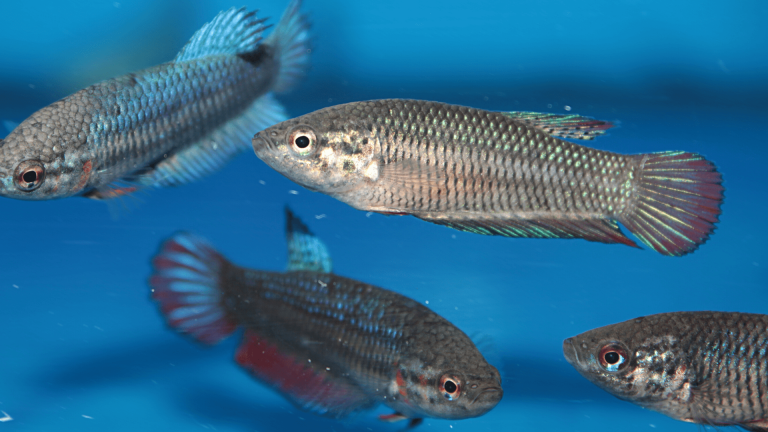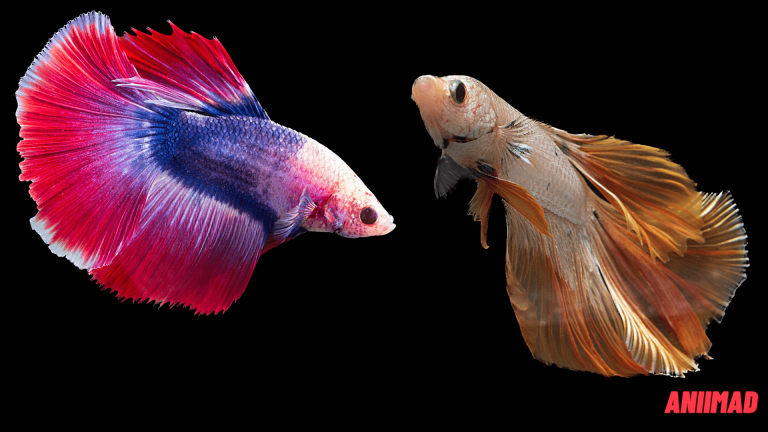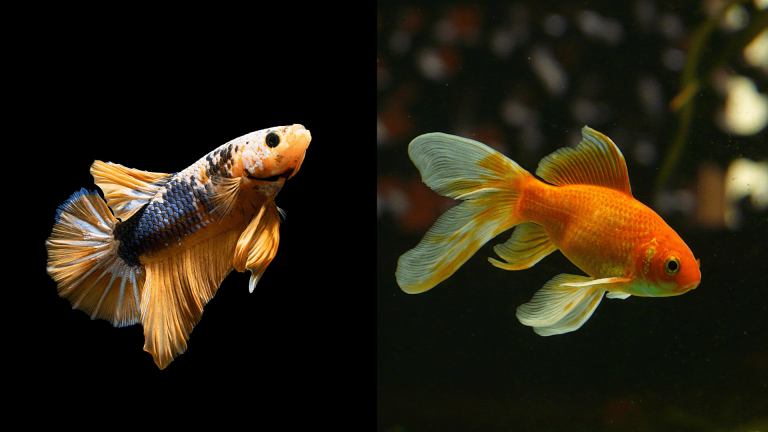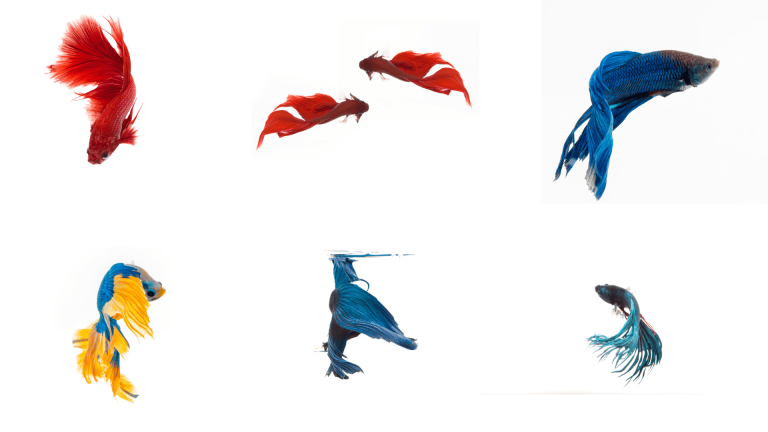7 Different Types of Betta Fish | Discover the Fascinating World of Betta Fish
7 Different Types of Betta Fish : Discover the Fascinating World of Betta Fish. Siamese fighting fish, commonly called betta fish, are renowned for their vivid colors, flowing fins, and alluring personalities. These exquisite aquatic creatures have captivated fish enthusiasts for centuries. This article will explore the diverse world of betta fish, exploring the different types and varieties available today. Whether you’re a seasoned fish keeper or a beginner looking to start your betta fish collection, this guide will help you appreciate the stunning array of colors and patterns these fish possess.
Here are 7 Different Types of Betta Fish
01. Veil Tail Betta (Betta splendens)

The Veil Tail Betta is the most common and readily available type of betta fish. It features long, droopy fins that flow elegantly, creating a mesmerizing effect. These fish often find in various colors, including red, blue, and white.
02. Crowntail Betta (Betta splendens)

The Crowntail Betta is known for its stunning finnage, characterized by long, distinct rays resembling a crown’s peaks. This type of betta fish displays a wide range of vibrant colors, and the unique appearance of its fins adds an extra level of beauty to its overall aesthetic.
03. Halfmoon Betta (Betta splendens)

The Halfmoon Betta is a true spectacle. Its caudal fin forms a perfect 180-degree semicircle when fully extended, creating a stunning display reminiscent of a half-moon.
04. Plakat Betta (Betta splendens)
The Plakat Betta, also known as the “short-finned” betta, is the wild-type variation of betta fish. Plakats have shorter fins, unlike other bettas, allowing for faster and more agile swimming. They come in various colors and are known for their robustness and resilience.
05. Delta Betta (Betta splendens)
The Delta Betta’s tail shape, which forms a “D” when completely grown, gave rise to its name. While not as dramatic as the Halfmoon Betta, Deltas still possess an impressive finnage that creates a beautiful display. They come in various colors, making them popular for betta enthusiasts.
06. Rosetail Betta (Betta splendens)
The Rosetail Betta is a variant of the Halfmoon Betta, exhibiting an even more elaborate finnage. Its caudal fin rays are heavily branched, creating a rose-like appearance. These bettas require special care due to the delicate nature of their fins but reward keepers with their exquisite beauty.
07. Double Tail Betta (Betta splendens)
As the name suggests, the Double Tail Betta possesses a unique feature—two distinct tails instead of one. This trait gives them a special appearance, and when the tails fully extend, they create a striking spectacle. They are available in a wide range of colors and are popular among betta enthusiasts.
How Many Types of Betta Fish Are There
There are numerous betta fish types and variations, with new ones being selectively bred and discovered over time. While providing an exact number is challenging, I can list some famous and well-known types of betta fish. It’s important to note that this list is not exhaustive, as betta fish breeding continues to produce new and unique variations:
- Veil Tail Betta
- Crowntail Betta
- Halfmoon Betta
- Plakat Betta
- Delta Betta
- Rosetail Betta
- Double Tail Betta
- Combtail Betta
- Super Delta Betta
- Halfmoon Plakat Betta
- Halfmoon Rosetail Betta
- Giant Betta
- Dumbo Betta
- Over-Halfmoon Betta
- Rose Petal Betta
- Mustard Gas Betta
- Dragon Scale Betta
- Marble Betta
- Butterfly Betta
- Copper Betta
These are just a few examples of the diverse betta fish available. Each type varies in fin shapes, color patterns, and other physical characteristics. It’s worth exploring the vast array of betta fish available in local fish stores, breeders, and online platforms to truly appreciate the wide range of options for these beautiful and captivating fish.
Which Type of Betta Fish is Best
Determining the “best” type of betta fish is subjective and depends on individual preferences and interests. Each type of betta fish has its own unique characteristics and aesthetic appeal. Here are a few factors to consider when choosing a betta fish:
01. Personal Preference
Consider what features and traits you find most appealing in a betta fish. Do you prefer long, flowing fins or shorter, more compact fins? Are you drawn to vibrant colors or intricate patterns? Determining your personal preferences will help guide you toward the type of betta fish that resonates with you the most.
02. Care Requirements
Different types of betta fish may have slightly different care needs. Some varieties, such as Halfmoon Betta or Rosetail Betta, may require more attentive care due to their delicate fins. On the other hand, Plakat Betta or Crowntail Betta, with their shorter fins, may be hardier and more resilient. Consider your experience level and ability to provide the necessary care for the specific type of betta fish you are interested in.
03. Availability
Availability can vary depending on location and local breeders. While some types, like Veil Tail or Crowntail Bettas, are readily available, others may be rare or harder to find. Consider what types of betta fish are accessible to you and whether you are willing to invest time and effort in searching for a specific type.
Ultimately, the “best” type of betta fish is the one that captures your heart and aligns with your preferences and capabilities as a betta fish keeper. Take your time to explore and appreciate the various types of betta fish, and choose the one you find most visually appealing and feel confident in caring for.
What is the Strongest Betta Fish?
Typically, betta fish don’t measure their strength in terms of aggression or raw force. Instead, “strongest” can refer to the overall health, resilience, and ability to thrive in different conditions. That say, betta fish, regardless of their type, can exhibit strength and vitality when provided with proper care and a suitable environment.
Factors that contribute to the overall strength and well-being of betta fish include:
01. Good Genetics
Bettas bred from healthy and robust bloodlines tend to have more muscular immune systems and better overall health.
02. Proper Nutrition
A balanced diet is essential for betta fish to grow. High-quality betta-specific pellets, supplemented with occasional treats like frozen or live foods, can help promote their strength and vitality.
03. Water Quality
Maintaining excellent water quality is essential for the health of betta fish. Regular water changes, appropriate filtration, and monitoring of water parameters (such as temperature, pH, and ammonia levels) are essential for creating a clean and stable environment.
04. Adequate Space
Giving betta fish enough space to swim and explore is vital for their physical and mental well-being. A tank that meets the minimum recommended size of 5 gallons (19 liters) or larger provides ample room for their activities.
05. Environmental Enrichment
Providing hiding spots, live or silk plants, and suitable tank decorations can enrich the betta fish’s environment. It helps alleviate stress and allows them to display their natural behaviors, promoting their overall strength and happiness.
Remember, betta fish, like any living creature, have unique personalities and temperaments. While some bettas may appear more active or assertive, focusing on providing the best care possible is essential rather than seeking out the “strongest” betta fish. By prioritizing their well-being and creating an optimal environment, you can help your betta fish thrive and showcase their natural strength and beauty.
Here are Some Frequently Asked Questions About Different Type of Betta Fish
What are the different types of betta fish?
There are numerous types of betta fish, each with unique characteristics. Some popular varieties include Veil Tail Betta, Crowntail Betta, Halfmoon Betta, Plakat Betta, Delta Betta, Rosetail Betta, Double Tail Betta, Combtail Betta, Super Delta Betta, and Giant Betta, among others.
What is the difference between Veil Tail and Crowntail Bettas?
Veil Tail Bettas have long, floppy fins that flow elegantly, while Crowntail Bettas have long, distinct fin rays resembling crown peaks. Veil Tails have a more traditional appearance, while Crowntails have a unique and spiky finnage.
What is the distinguishing feature of a Halfmoon Betta?
The defining characteristic of a Halfmoon Betta is its caudal fin, which forms a perfect 180-degree semicircle when fully extended. It creates a stunning display resembling a half-moon shape.
How is a Plakat Betta different from other types?
Plakat Bettas, also known as “short-finned” bettas, have shorter fins than other varieties. They exhibit faster and more agile swimming abilities and are known for their robustness and resilience.
What sets a Rosetail Betta apart from other betta types?
Rosetail Bettas are a variant of Halfmoon Bettas. They have heavily branched caudal fin rays, creating a rose-like appearance when fully extended. They require special care due to the delicate nature of their fins.
What makes a Double Tail Betta unique?
Double Tail Bettas have two distinct tails instead of the usual single tail. This characteristic creates a striking appearance; they create a captivating spectacle.
Are there differences in care requirements among betta types?
While betta types generally have similar care requirements, some variations may need more attention due to their delicate fins, such as Halfmoon or Rosetail Bettas. Short-finned varieties like Plakat or Crowntail Bettas are often hardier and more resilient.
Can different types of betta fish be housed together?
It is generally not recommended to house different types of betta fish together, especially males, as they can be aggressive and territorial. They are better kept individually in separate tanks to prevent fighting and injury.
Can betta fish change colors over time?
Yes, betta fish can exhibit color changes or intensification of their hues as they grow and mature. Some bettas may also undergo a natural process called marbling, where their colors and patterns transform or develop unpredictably.
How long do betta fish typically live?
With proper care, betta fish can live an average of 3 to 5 years, although some individuals may live longer. Providing a suitable habitat, a balanced diet, and regular maintenance can contribute to their longevity.
While these answers provide general information, specific variations or exceptions may exist within each betta type.
Conclusion
In conclusion, the world of betta fish fills with a captivating array of different types and variations. From the graceful and flowing fins of Veil Tail Bettas to the intricate crown-like rays of Crowntail Bettas, each type possesses its unique beauty. The Halfmoon Betta showcases a stunning semicircular tail, while the Plakat Betta stands out with its shorter fins and agility. Rosetail Bettas exhibit elaborate and rose-like finnage, while Double Tail Bettas captivate with their two distinct tails.
While each type has its visual appeal, it’s essential to consider personal preference, care requirements, and availability when choosing a betta fish.
Exploring the different types of betta fish opens up a world of colors, patterns, and personalities. Whether you’re a seasoned betta enthusiast or a newcomer to the hobby, the diversity of betta fish provides an opportunity to appreciate nature’s wonders and cultivate a rewarding and fulfilling companionship with these beautiful aquatic creatures.





